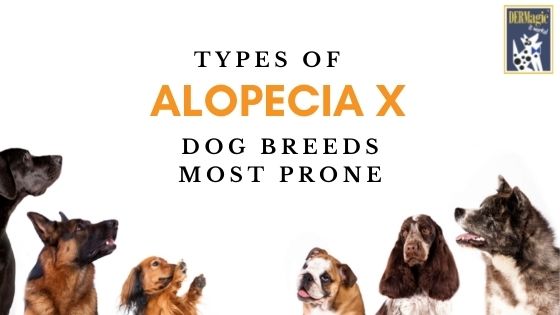
Alopecia X is a frustrating diagnosis to receive from your veterinarian. It essentially means "loss of hair due to unknown cause". No one likes these types of vague diagnosis, not even your vet.
Is Alopecia X Breed-Specific?
This is a complex question and we don’t have a definite answer. We do know that Alopecia X can impact any breed at any time, but some breeds are more prone to the condition. Pomeranians and other Nordic breeds seem to be the most susceptible to this issue.
We don’t yet know if this is a result of genetics, breeding practices, diet, endocrine disorders, or other issues.
Is fur loss from Alopecia X always due to yeast?
No. Not all hair loss or diagnosis of Alopecia X is the result of yeast, which means that DERMagic may not be able to treat every case. DERMagic is specifically formulated to handle Alopecia X that results from yeast.
What other factors cause Alopecia X?
There are many other factors that can contribute to hair loss in pets. These include:
- Diet: Over the years of treating this condition, we have discovered that diet plays an important role in managing yeast. You can learn more about diet for your pets here.
- Environment: Stress from external conditions can impact your pet. This includes stress from other animals, people, or other causes. Mud (such as Alabama Mud Rot) and dust (a cause of Valley Fever in the Southwest) can also result in Alopecia X.
- Allergies: True allergies are very rare in pets. But, there are exceptions. Certain food allergies are more common than environmental reactions. We also see many allergic reactions to fleas.
- Medications: Most medications used to treat Alopecia X and Black Skin Disease result in even worse cases. These include corticosteroids, antibiotics, and more. Together, they create a "perfect storm" that makes the condition even worse.
- Congenital Disorders: These are generally not commonly seen, but are possible. Learn more about hereditary and congenital disorders here.
- Endocrine Disease. Endocrine glands (which includes the pituitary, thyroid, and adrenal glands) help control many body functions, including growth and development, metabolism, and fertility. This is why its recommended to have your pets spayed or neutered and to avoid breeding dogs with a history of fur loss.
While Alopecia X means “hair loss”, there are various patterns of loss depending on the form of the alopecia. These are a few of the more common patterns we see fairly often:
Pinnal Alopecia
Pinnal means "relating to the ear". With this pattern of fur loss, the ear flaps are primarily affected.
This pattern is very common in Dachshunds, Italian Greyhounds, Chihuahuas, Boston Terriers, and Whippets.
Pattern Baldness
Pattern baldness results in specific areas of fur loss, often over and behind ears, on the legs and on the belly. Females tend to be predisposed to this issue. In most dogs, this pattern of baldness begins around the age of 6 months and progresses to near baldness over the next year.
We see this in Pomeranians and Dachshunds, as well as short-coated breeds like Boxers, Boston Terriers, Chihuahuas, Whippets, Manchester Terriers, Greyhounds, and Italian Greyhounds.
Post-clipping alopecia
Most dogs we treat with Alopecia X are a result of this type of alopecia. Close clipping to skin allows yeast to more easily penetrate the skin, resulting in severe alopecia x.
Please don’t clip your dogs unless absolutely necessary for surgery! Here are 5 ways shaving your pet can create a lifetime of problems.
Some owners feel that their double-coated Arctic breeds (including Siberian Huskies, Alaskan Malamutes, Keeshonds, German shepherd, Chow Chows, and Samoyeds) need to be clipped in summer, but this is not only unnecessary, it is very dangerous for the dog.
Post-injection alopecia
While very rare, some have seen Alopecia X appear as a patch of hair loss that is confined to a rabies vaccination site.
Toy or small-breed dogs, especially Poodles, but also Bichon Frises, Shih-tzus, and Yorkshire and Silky Terriers seem to be most susceptible to this type of reaction.
Alopecia Areata
With this pattern, the head and neck are most likely to suffer alopecia but the loss of hair can happen anywhere on the body with this disease. Over time, the areas of hair loss may turn grey or black with hyper pigmentation, which we refer to as Black Skin Disease.
We see this type of condition in many breeds, including the Pomeranian, Chihuahua, Yorkshire terriers, Bully breeds, and more.
Color Dilution Alopecia
Color dilution alopecia results in generalized hair loss, skin dryness and bumps related to secondary infection of the hair follicle as a result of yeast. This is typically seen starting in 6 month-old pups and progressing into adulthood.
This condition is often seen in Dobermans and Pomeranians, but is also found in Bernese Mountain Dogs, Salukis and blue-colored dogs of the following breeds: Chihuahuas, Chow Chow, Dachshund, Great Dane, Irish Setter, Miniature Pinscher, Schipperke, Shetland Sheepdog, Standard Poodle, Whippet, and Yorkshire Terrier.
This by no means a complete list of all types of alopecia, but is a good summation of our findings over the years. For additional reading, check our reference section under the "Info" and "Blog" tabs on our home page.
References
- Rosenbaum, Michele, 2001. Focal, non-inflammatory alopecia: A diagnostic, treatment challenge. DVM Newsmagazine.
- Scott, D.W., Miller, W.H., Griffin, C.E. 1995. Muller and Kirk's Small Animal Dermatology. p. 777.
- W.B. Saunders Co., Toronto. Power, H.T., Ihrke, P.J. 1995. The use of synthetic retinoids in veterinary medicine. In S.J. Ettinger and E.C. Feldman (eds.) Textbook of Veterinary Internal Medicine. p 585-590. W.B. Saunders Co., Toronto.

